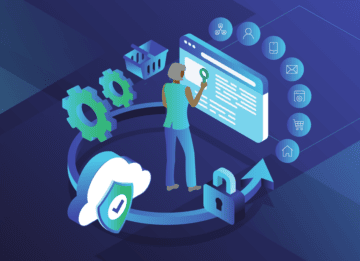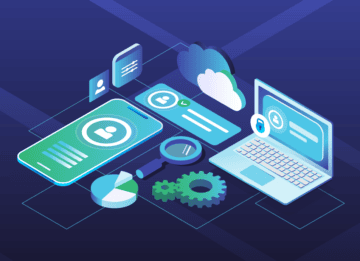
The 4 biggest data onboarding challenges—solved
Think about the last time you tried to buy something big, like a phone.
Research shows that you’ll probably start online (46% on Google, 54% on Amazon). But once you have your shortlist, you’ll probably speak with your co-workers, friends, or family and come back online to verify what they tell you. Then you might jump back online to follow up on their recommendations, or visit a store to check on the phones in person.
This entire process happens organically—you don’t think about the switch from online to offline. But for a business trying to map out your journey and connect with you more meaningfully, it’s difficult to plot those offline interactions.
That’s where data onboarding comes in.
What is data onboarding?
Data onboarding is the process of bringing offline data to an online environment in order to use it to improve customer experiences—and, ultimately, acquisition and retention. The business collects first-party customer data (such as names, email addresses, phone numbers, transactions, etc.) from various sources, all in various formats, and relies on data onboarding solutions to align this information to individual customer profiles.
This data onboarding process allows you to recognize your customers in future interactions and relate to the contextual decisions they make throughout their buyer’s journey.
How data onboarding works
There are three general steps to the data onboarding process:
-
- Upload the data—This step includes removal of personally identifiable information (PII) of offline first-party data and uploading into the enterprise’s platform, such as a DSP or CDP.
- Match to a person—Align the offline data points with individual device IDs and other online identifiers. In other words, match the offline data to people you know online.
- Activate relevant marketing—Once you’ve matched the offline data to online profiles, create audience segments and serve these segments relevant marketing messages that correspond to specific attributes and behaviors.
Why marketers need to bring offline data online
Today, marketing is an identity-driven science, as well as an art. Maintaining conversions is a delicate interplay of providing great products and engaging meaningfully with customers. Your first-party data provides important context about who these people are and what they’re interested in. When activated well, these insights result in more meaningful engagement.
Incorporating your CRM data into your digital engagements also helps to create successful marketing outreach efforts. Targeted advertising cuts down marketing spend while increasing conversions.
Additional benefits of data onboarding include:
-
- Providing a more complete picture of people in your target audience (e.g. unified customer view or single customer view)
- Improving insights from omnichannel marketing and outreach efforts
- Recognizing customers when they show up on your website
- Removing existing customers from acquisition campaigns
- Designing effective targeted outreach for lapsed customers
- Provide insights for ad and campaign personalization
Starbucks offers the perfect use case
During the economic crisis of 2009, Starbucks suffered a 70% slump in quarterly profits (people just weren’t buying that pricey coffee).
Starbucks executives decided to revamp their marketing efforts with the goal of staying top of mind for consumers throughout the slump. The idea was that once customers’ purchasing power improved again, they’d hurry back to their neighborhood Starbucks.
To fuel this effort, Starbucks finally woke up to the data treasure it had been sitting on for years—in-store interactions. The coffee giant integrated this offline data with the rest of their digital details to create more memorable experiences in all channels.
Online, users could track promotions and discounts in nearby stores, learn more about their favorite drinks, or exchange banter with other coffee lovers on social media. In-store, users had Wi-Fi and access to exclusive content, including books, music, videos, films, and news.
Starbucks also increased mobile payment options, created loyalty card programs, and enabled online ordering. And all of the data from these interactions could be used to power more and more relevant experiences for Starbucks customers.
This is a perfect example of how bringing offline data online—way ahead of its time in 2009—helped Starbucks to bounce back following the crisis.
4 challenges with the data onboarding process
Considering how important data onboarding is for marketers and marketing campaigns, there haven’t been fabulous solutions for getting it done. Until recently, only a couple of big players have dominated the market.
If you’ve been working through the data onboarding process, you’ve probably grappled with some of the following challenges.
1. Heavily complex, manual processes
Even with leading tools, there’s a lot of manual work to be done when it comes to tasks like:
-
- Implementing data onboarding tools—Tech teams have been burdened with long, complex integrations.
- Activating audiences—It can be a cumbersome process to push a custom audience to an activation channel (like a DMP, DSP, streaming service, etc.). Sending files to SFTP folders, downloading and uploading CSVs, it all takes time and effort.
2. Long turnaround times
It can take days—or even weeks—using common data onboarding tools to match your CRM data to the customer profiles in your CDP.
What customer wants to wait weeks for anything these days?
Delays in your matching and activation can mean increases in customer churn or decreased conversions. Without real-time insights, the business must resort to delayed insights, which are only slightly better than no insights.
3. Ambiguous match rates
How many of the offline interactions in your data set actually mapped to a real person? Unfortunately, most data onboarding solutions don’t offer a lot of transparency into match rates or the matching process.
It’s hard to accurately measure your performance—and ROI—when you can’t be confident that you’ve found the people you’re trying to reach.
4. No control of your first-party data
As data protection laws and regulations get more stringent, businesses must do more to protect their customers’ data.
But when you share your first-party data with many data onboarding providers, they end up using that data to build and monetize their own assets. They pool it with data from other brands to build things like identity graphs, for example.
This means you lose control of your own first-party data, and it introduces a new privacy risk to your data ecosystem.
FullContact + Lotame partnership streamlines data onboarding
FullContact and Lotame have announced a new partnership that addresses many of these snags to make the onboarding process:
-
- Easier
- Faster
- More reliable
- Privacy-centric
When onboarding clients’ first-party data to Lotame, FullContact’s Resolve identity resolution product offers a significantly higher match rate to Lotame’s Panorama ID™. The collaboration also offers faster match results through our custom integration, which allows Lotame customers to more quickly leverage their first-party data for monetization, audience expansion, targeting, measurement, and more.
The solution also allows Lotame customers to protect and maintain control of their first-party data—FullContact will never share or make use of client’s data for derivative purposes.
“Marketers have been frustrated with the onboarding solutions available to them,” explains Christopher Harrison, FullContact CEO. “Existing solutions often take a week or two to match offline data to online IDs, and match rates are subpar. This partnership presents a new option that lets brands onboard, enrich, and activate their data better and faster than before—while respecting an individual’s privacy.”
Learn more about the FullContact + Lotame partnership.
Get to market faster with more meaningful interactions
The value in merging customers’ online and offline data is obvious, but it can be difficult to efficiently implement traditional data onboarding solutions to activate your-first party data.
Now, you can turn these common challenges into a competitive advantage by onboarding and standardizing your data more quickly and effectively. The result is getting to market faster with more relevant and meaningful customer interactions.
That’s the power of data onboarding.
Recent Blogs
-
 February 25, 2025 Introducing Email Signals: Unlock Powerful Email Engagement Insights Customer 360, Customer Experience, Marketing & Sales, Enrich API
February 25, 2025 Introducing Email Signals: Unlock Powerful Email Engagement Insights Customer 360, Customer Experience, Marketing & Sales, Enrich API -
 August 28, 2024 The Sales Rep's Guide to Maximizing Productivity with Website Visitor Data Acumen, Media Personalization, Marketing & Sales
August 28, 2024 The Sales Rep's Guide to Maximizing Productivity with Website Visitor Data Acumen, Media Personalization, Marketing & Sales -
 August 6, 2024 Turn Visitors into Leads: How to Install the Acumen Web Tag in 5 Easy Steps Acumen, Website Recognition
August 6, 2024 Turn Visitors into Leads: How to Install the Acumen Web Tag in 5 Easy Steps Acumen, Website Recognition